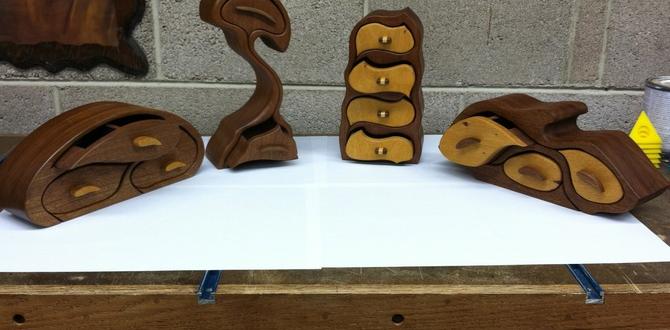For impressive wood projects, a top-rated framing nailer is your best friend. It drives large nails quickly and powerfully, making framing walls, building decks, or assembling heavy furniture a breeze. Choosing the right one means faster, stronger, and more beautiful results for your DIY endeavors.
Hey there, fellow DIYers! Jack Shaffer here from Nailerguy. Ever looked at a beautiful wooden deck or a sturdy backyard shed and thought, “How did they build that so quickly?” More often than not, the secret weapon is a framing nailer. These powerful tools are designed to drive big nails with serious speed and force, perfect for connecting heavy lumber. If you’ve been struggling with manual nailing for your larger projects, or felt intimidated by these mighty machines, you’ve come to the right place. We’re going to break down what makes a framing nailer great and how it can turn your ambitious wood projects from dreams into reality. Get ready to discover the power and convenience that a top-rated framing nailer can bring to your workshop!
Table of Contents
Why a Framing Nailer is a Woodworker’s Best Friend
Let’s be honest, tackling big woodworking projects with just a hammer and nails can be exhausting and, frankly, a bit slow. For anything involving structural elements or heavy-duty construction, you need something more. That’s where a framing nailer shines. It’s specifically engineered to handle the demands of building with larger pieces of wood.
Think about framing an entire wall for a shed or a small addition. Each joint requires multiple nails. Doing this by hand would take hours and leave your arm feeling like it’s going to fall off. A framing nailer can sink those same nails in a fraction of a second. This kind of speed and efficiency is invaluable, especially when you’re on a deadline or just want to get your project finished and enjoy it.
But it’s not just about speed. Framing nailers are built for power. They drive nails deeper and more consistently than you can with a hammer. This ensures strong, secure connections that are crucial for the structural integrity of your projects. Whether you’re building a deck that needs to withstand the elements or a sturdy workbench that can handle heavy tools, the reliable power of a framing nailer makes all the difference.
Understanding the Different Types of Framing Nailers
Before we dive into specific recommendations, it’s helpful to know the main types of framing nailers. Each has its own advantages, making one a better fit for different situations and preferences.
1. Pneumatic Framing Nailers
These are the workhorses of the framing world. Pneumatic nailers run on compressed air from an air compressor.
Pros:
- Power: They offer the most power and can easily drive large nails into dense wood.
- Durability: Generally very reliable and built to last.
- Lightweight (Tool): The tool itself is often lighter because the motor is in the compressor.
- Cost: Often more affordable upfront than other types.
Cons:
- Tethered: You’re limited by the length of your air hose and need an air compressor, which adds noise and bulk.
- Setup Time: Requires connecting hoses and ensuring the compressor is ready to go.
2. Cordless Framing Nailers (Battery-Powered)
These are the modern marvels, offering freedom from air hoses thanks to powerful battery technology.
Pros:
- Portability: Complete freedom of movement around the job site.
- Convenience: No hoses, no compressor needed – just grab and go.
- Still Powerful: Modern battery models pack a serious punch.
Cons:
3. Fuel-Powered Framing Nailers
These innovative tools use a combination of a small battery and a propane-based fuel cell to drive nails.
Pros:
- Cordless: No hoses or compressors needed.
- Compact Power: Can be very powerful and have a good power-to-weight ratio.
- Good for Cold Weather: Less affected by cold temperatures than some battery-only models.
Cons:
Choosing the Right Framing Nailer for Your Projects
So, which type is right for you? It really comes down to your typical projects and priorities:
- For Heavy, Frequent Construction (Sheds, Decks): A robust pneumatic framing nailer is often the most economical and powerful choice if you don’t mind the air compressor.
- For Maximum Portability and Convenience: A cordless battery-powered framing nailer is the way to go, especially if you move around your worksite a lot or don’t have easy access to power.
- For Occasional, Tough Jobs Without Compressor: A fuel-powered nailer can be a good compromise, offering cordless freedom and strong performance.
When looking at specific models, consider these features:
- Nail Size Capacity: Ensure it can handle the lengths and diameters of nails you’ll need for your projects. Most range from 2 inches to 3.5 inches.
- Depth Adjustment: The ability to easily adjust how deep the nail is driven is crucial for preventing over- and under-driving.
- Rafter Hook: A handy feature for temporarily hanging the nailer on a joist or rafter.
- Sequential vs. Contact Firing: Sequential firing (pulling the trigger for each nail) is safer and more precise. Contact firing (bumping the nose against the wood while the trigger is held) is faster for rapid nailing. Many modern nailers offer a selectable trigger.
- Jam Clearing: Look for tools with easy, tool-free jam clearing mechanisms.
Top-Rated Framing Nailers for Your Genius Wood Projects
Based on performance, reliability, and user feedback, here are some of the top-rated framing nailers that beginners and experienced woodworkers alike love for their heavy-duty projects.
| Nailer Model | Type | Key Features | Best For |
|---|---|---|---|
| DEWALT 20V MAX XR Brushless Cordless Framing Nailer | Cordless (Battery) | Brushless motor, tool-free depth adjustment, selectable trigger, lightweight. | All-around excellent cordless performance for framing, decks, and renovations. Great for portability. |
| Metabo HPT (Hitachi) NR90AES2 | Fuel-Powered | Lightweight, powerful, good balance, side load magazine for quick reloads. | Users who need cordless freedom but prefer gas power for consistent drive. Good for jobs where compressor use is difficult. Note: While Metabo HPT is the new branding, many still refer to this popular model by its Hitachi name. |
| PORTER-CABLE PC660B (or similar pneumatic model) | Pneumatic | Durable construction, consistent nailing, reliable performance, often a budget-friendly option for serious power. | Woodworkers who already own or plan to buy an air compressor and want robust, consistent power for large framing jobs. Offers excellent value. |
| Milwaukee M18 FUEL 30 Degree Framing Nailer | Cordless (Battery) | M18 FUEL technology for maximum power, consistently sinks nails, dry-fire lockout, excellent ergonomics. | Professional remodelers and serious DIYers who demand top-tier cordless performance and power. Excellent for framing walls and larger structures. |
| Paslode Cordless 30 Degree Framing Nailer | Fuel-Powered | Industry-leading battery/fuel system, reliable performance, good for professionals and serious DIYers needing cordless convenience. | A long-standing favorite for its robust performance and cordless freedom. Excellent for both field use and dedicated workshops where a compressor isn’t practical. |
Important Note: Tool models and availability can change. Always check the latest specifications and reviews before purchasing. Clicking the links provided will take you to the manufacturer’s official pages for the most current product information. For detailed comparisons and user reviews, sites like ToolReviews.com or reputable hardware store websites are great resources.
Genius Wood Projects You Can Tackle with a Framing Nailer
Now for the fun part! What can you actually build with a top-rated framing nailer? The possibilities are vast, especially for projects that require strong, quick connections of larger lumber. Here are some ideas to get your creative juices flowing:
1. Building a Sturdy Deck
This is perhaps the most classic use for a framing nailer. Building a deck involves securely attaching joists, beams, and decking boards. A framing nailer makes quick work of driving the large nails needed to connect these structural elements, ensuring a safe and long-lasting deck for your outdoor enjoyment.
- Joist to Beam: Use 3-inch or 3.5-inch framing nails to secure joists to ledger boards and support beams.
- Decking Boards: While some prefer screws, framing nails can be used to quickly attach decking boards to joists, especially for less critical areas or where speed is paramount.
- Railing Posts: Securely attach railing posts to the deck frame.
2. Constructing a Backyard Shed or Playhouse
Want to build that dream shed for your garden tools or a magical playhouse for the kids? A framing nailer is essential here. You’ll be building wall frames, roof trusses, and attaching siding quickly and efficiently.
- Wall Framing: Studs to top and bottom plates, corner bracing.
- Roof Rafters and Trusses: Connecting rafters to the ridge board and wall plates.
- Sheathing (Plywood/OSB): Quickly attach wall and roof sheathing.
- Siding: Easily attach various types of siding.
3. Creating Robust Furniture
Don’t underestimate the power of a framing nailer for building heavy-duty furniture. Think about solid workbenches, potting benches, or even a rustic dining table frame.
- Workbench Frames: Building a solid base and apron for a workbench.
- Outdoor Furniture: Sturdy benches, planters, and outdoor tables.
- Cabinet Carcasses: For very large or robust cabinet builds, a framing nailer can speed up assembling the main box structures.
4. DIY Fencing and Gates
Building a new fence or reinforcing an existing one? A framing nailer will significantly speed up the process of attaching fence pickets to rails and can be used to construct strong, durable gates.
- Picket to Rail: Quickly secure pickets to horizontal rails.
- Gate Frames: Constructing the frame for a new gate.
5. Minor Home Additions and Renovations
For those looking to take on slightly more ambitious DIY home improvement, a framing nailer is a game-changer. This could include framing a small interior wall for a renovation, building dormers, or even adding structural supports.
- Framing Interior Walls: For new layouts or closet additions.
- Window and Door Framing: Creating rough openings and installing headers.
Safety First: Using Your Framing Nailer Responsibly
These tools are powerful, and with great power comes great responsibility! Safety should always be your top priority when operating any power tool, especially a framing nailer.
- Read the Manual: Seriously, take the time to read your tool’s instruction manual. It contains crucial safety information specific to your nailer.
- Wear Safety Glasses: Always wear ANSI-approved safety glasses or a full face shield. Flying debris or nail fragments are a real hazard.
- Ear Protection: Framing nailers can be loud. Earplugs or earmuffs will protect your hearing.
- Gloves: Work gloves protect your hands from splinters and minor abrasions.
- Footwear: Sturdy work boots are essential to protect your feet from dropped tools or lumber.
- Never Point at Yourself or Others: Treat the nailer like a loaded firearm. Never point it at any part of your body or anyone else.
- Understand Firing Modes: Be aware of whether your nailer is in sequential or contact fire mode. Use sequential for precision and safety.
- Keep Fingers Off the Trigger: When not actively firing a nail, keep your finger off the trigger.
- Secure Your Workpiece: Ensure your lumber is stable and won’t shift while you’re nailing.
- Be Aware of Your Surroundings: Make sure no one is behind the material you are firing into, as nails can over-penetrate.
Following these simple safety guidelines will ensure you can enjoy the benefits of your framing nailer without incident. For more in-depth safety information, resources like the Occupational Safety and Health Administration (OSHA) offer excellent guidance on nail gun safety.
Maintenance for Longevity
To ensure your top-rated framing nailer performs reliably for years to come, a little maintenance goes a long way.
Pneumatic Nailers:
- Lubrication: Add a few drops of pneumatic tool oil into the air inlet daily or before each use, as recommended by the manufacturer.
- Air Filter: Check and clean the air filter regularly to prevent dust and debris from entering the tool.
- Air Pressure: Always use the recommended air pressure. Too much can damage the tool; too little will reduce performance. A guide to air compressors from Fine Homebuilding can be helpful.
- Hoses: Inspect air hoses for leaks or damage.
Cordless (Battery) Nailers:
- Battery Care: Store batteries in a cool, dry place and follow manufacturer guidelines for charging and storage to maximize their lifespan.
- Cleanliness: Keep the tool clean, especially the magazine and nose area, to prevent jams.
- Check O-Rings and Seals: While less common for DIYers, occasional checks can prevent leaks.
Fuel-Powered Nailers:
- Fuel Cell Replacement: Follow manufacturer recommendations for replacing fuel cells.
- Cleaning the Tool: Regularly clean the internal components of the tool as per the manual to remove carbon buildup.
- Battery Charging: Keep the small onboard battery charged.
A well-maintained tool is a safe tool and a productive tool. It means fewer frustrating jams and more successful project completions.
Frequently Asked Questions About Framing Nailers
Q1: What size nails does a framing nailer use?
Framing nailers typically use nails ranging from 2 inches up to 3.5 inches in length, with a diameter that varies depending on the specific tool. They are designed for substantial construction projects.
Q2: Do I need an air compressor for a framing nailer?
Only if





